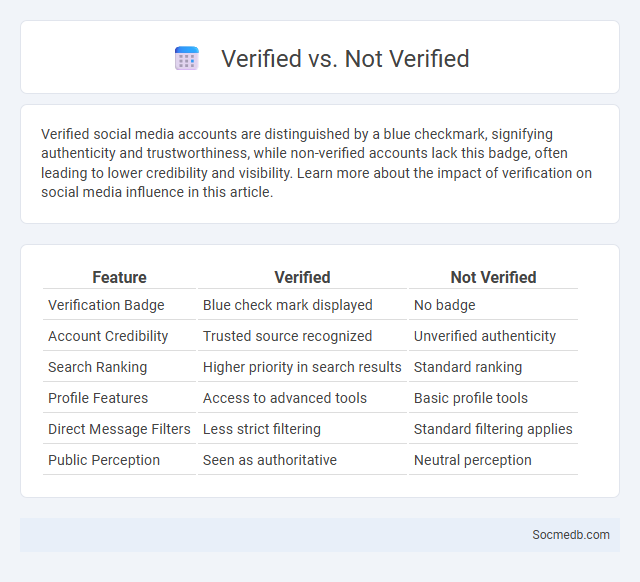
Photo illustration: Verified vs Not Verified
Verified social media accounts are distinguished by a blue checkmark, signifying authenticity and trustworthiness, while non-verified accounts lack this badge, often leading to lower credibility and visibility. Learn more about the impact of verification on social media influence in this article.
Table of Comparison
| Feature | Verified | Not Verified |
|---|---|---|
| Verification Badge | Blue check mark displayed | No badge |
| Account Credibility | Trusted source recognized | Unverified authenticity |
| Search Ranking | Higher priority in search results | Standard ranking |
| Profile Features | Access to advanced tools | Basic profile tools |
| Direct Message Filters | Less strict filtering | Standard filtering applies |
| Public Perception | Seen as authoritative | Neutral perception |
Understanding Verification: What Does It Mean?
Verification on social media signifies the authentication of an account, confirming its legitimacy to distinguish genuine profiles from impersonators or fake accounts. This process involves platforms like Twitter, Instagram, and Facebook providing verified badges or checkmarks, which enhance your credibility and trustworthiness to followers and potential connections. Understanding verification helps you navigate online interactions securely and maximize the impact of your digital presence.
The Evolution of Verified Badges on Social Platforms
Verified badges on social media platforms have evolved from simple blue checkmarks denoting authenticity to multifaceted symbols representing status, credibility, and influence across networks like Twitter, Instagram, and Facebook. Platforms now implement tiered verification systems, integrating AI-driven criteria and expanded eligibility to ensure Your profile's legitimacy and enhance trust in digital interactions. This evolution reflects growing demands for transparency and security in online communities, increasing the value of verified status for personal branding and business credibility.
Key Differences: Verified vs Not Verified Accounts
Verified social media accounts feature a distinct blue checkmark icon, signaling authenticity and credibility, while non-verified accounts lack this symbol, often resulting in lower trust from users. Verified accounts typically belong to public figures, celebrities, or brands and have access to enhanced platform features such as increased visibility, priority search ranking, and protection against impersonation. In contrast, non-verified accounts face higher risks of fake profiles and reduced engagement opportunities, impacting overall social media influence and reach.
What Is a Verified Badge and Why Does It Matter?
A verified badge on social media is a blue checkmark that confirms the authenticity of a public figure, brand, or entity's profile. This verification helps You distinguish genuine accounts from impersonators, enhancing trust and credibility in digital interactions. Platforms use this badge to signal verified status, which can increase engagement and influence within your network.
Benefits of Being Verified Online
Being verified on social media platforms like Instagram, Twitter, and Facebook enhances credibility by signaling authenticity to followers and potential clients. This verified status often leads to increased engagement rates, expanded reach, and better opportunities for brand partnerships and collaborations. Verified profiles also benefit from improved security features, protecting against impersonation and fostering user trust.
Risks and Limitations of Unverified Accounts
Unverified social media accounts pose significant risks such as spreading misinformation, enabling identity theft, and facilitating scams due to the lack of authentication. These accounts often contribute to the proliferation of fake news and fraudulent activities, undermining trust and safety on platforms like Facebook, Twitter, and Instagram. Users should exercise caution and verify sources to mitigate exposure to misleading content and potential cyber threats.
How to Obtain a Verified Badge: Essential Steps
Obtaining a verified badge on social media platforms like Instagram, Twitter, or Facebook requires submitting an official identification such as a government-issued ID, proof of brand authenticity, and meeting platform-specific eligibility criteria including follower count and account activity. Verification requests must be submitted through the platform's dedicated verification request forms often found in account settings or help centers. Maintaining consistent public interest, authentic content, and strict adherence to community guidelines significantly improves the chances of approval for a verified badge.
Myths and Misconceptions About Verification
Many users believe social media verification guarantees credibility, but it primarily confirms identity rather than trustworthiness. Another common misconception is that verification is an exclusive status reserved only for celebrities or influencers, while platforms often verify public figures, brands, journalists, and organizations to prevent impersonation. Verification badges do not imply endorsement by the platform, but they help users distinguish authentic accounts from potential fakes or bots.
Social Proof and Trust: Impact of the Verified Badge
The verified badge on social media platforms significantly enhances social proof by signaling authenticity and credibility to users, leading to increased trust and engagement. Studies show accounts with verification receive higher interaction rates, as the badge reduces uncertainty and skepticism about content legitimacy. Brands and influencers leverage this trust symbol to strengthen reputation, attract partnerships, and boost follower loyalty.
Future Trends: The Changing Landscape of Account Verification
The future of social media account verification is shifting towards biometric authentication and AI-driven identity analysis to enhance security against fake profiles and cyber threats. Platforms are increasingly adopting decentralized verification methods using blockchain technology to ensure transparency and user control over personal data. Enhanced real-time verification protocols will enable quicker validation processes, promoting trust and reducing misinformation spread across social networks.
 socmedb.com
socmedb.com